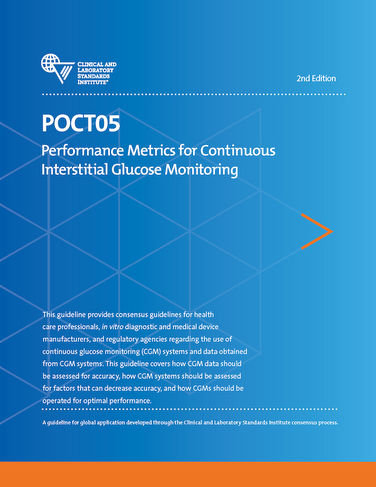You'll receive the latest updates on new standards, guidelines, and educational resources, as well as expert insights to help enhance your laboratory's performance and compliance.
Optimal Continuous Glucose Monitoring System Performance and Data Accuracy

Continuous glucose monitoring (CGM) systems are medical devices that measure glucose in the interstitial fluid just under the skin and use algorithms to predict blood glucose values from the measurement. The use of self-monitoring of blood glucose (SMBG) devices or glucose meters has led to more normal glucose levels and lower risk of cardiovascular and long-term complications in both type 1 and type 2 diabetes. Patients typically use SMBG devices to test blood glucose levels several times a day to plan diet and/or exercise, to manage diabetes medications, including insulin dosages, and to correct abnormal blood glucose values. Although these devices are easier to use than in the past, many diabetes patients do not comply with SMBG testing at the frequency recommended by their physician because of the cost of testing supplies, the pain of repeated SMBG measurements, the environmental drawbacks of blood and sharps waste, and the overall inconvenience of monitoring.
The CGM market is experiencing strong growth as accuracy, convenience, sensor duration, and data management capabilities improve and as patients, health care professionals, and payers see the benefits that these devices can provide in the management of glucose levels. Many clinical trials comparing CGM with other blood glucose monitoring methods have demonstrated decreases in mean glycemia, glycemic variability, and the incidence of hypoglycemia.
Optimal CGM system performance, as well as practical data comparisons between sensors, can be obtained by following the technical specifications presented in CLSI’s POCT05—Performance Metrics for Continuous Interstitial Glucose Monitoring. 2nd ed. POCT05 provides consensus information for health care professionals, in vitro diagnostic and medical device manufacturers, and regulatory agencies regarding how CGM data should be assessed for accuracy, how CGM systems should be assessed for factors that can decrease accuracy, and how CGMs should be operated for optimal performance. This guideline defines and explores multiple aspects of CGM performance, including use cases, point and trend accuracy, evaluation of threshold alerts, system stability and reliability, clinical studies for assessing CGM performance, calibration, and measurement traceability.